2020 HONDA CLARITY PLUG-IN engine
[x] Cancel search: enginePage 2 of 595
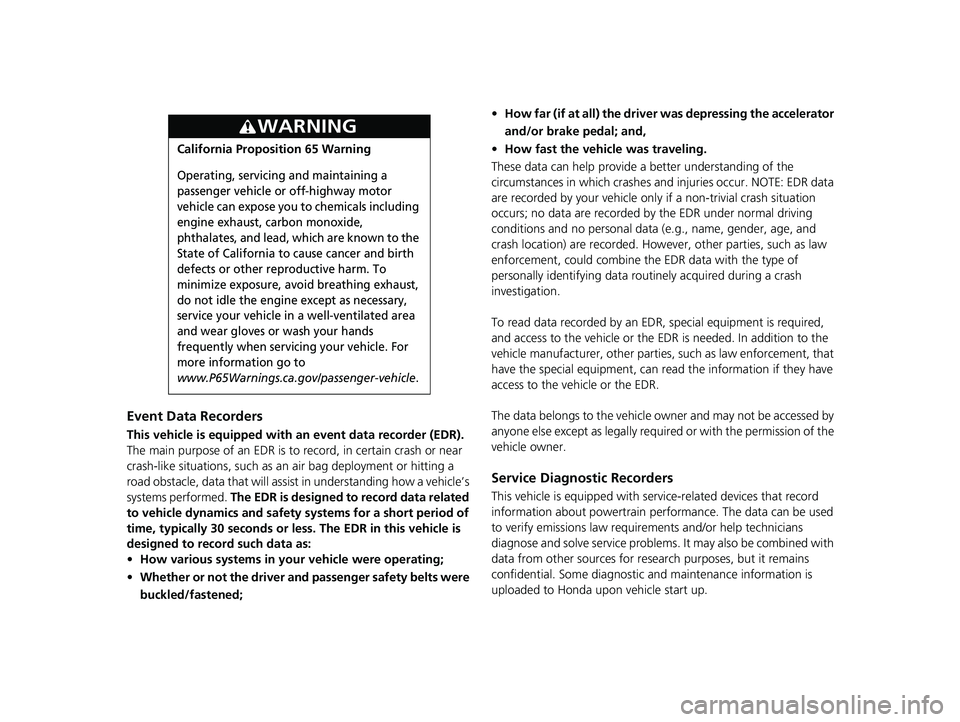
Event Data Recorders
This vehicle is equipped with an event data recorder (EDR).
The main purpose of an EDR is to record, in certain crash or near
crash-like situations, such as an air bag deployment or hitting a
road obstacle, data that will assist in understanding how a vehicle’s
systems performed. The EDR is designed to record data related
to vehicle dynamics and safety systems for a short period of
time, typically 30 seconds or le ss. The EDR in this vehicle is
designed to record such data as:
• How various systems in your vehicle were operating;
• Whether or not the driver and passenger safety belts were
buckled/fastened;
3WARNING
California Proposition 65 Warning
Operating, servicing and maintaining a
passenger vehicle or off-highway motor
vehicle can expose you to chemicals including
engine exhaust, carbon monoxide,
phthalates, and lead, which are known to the
State of California to cause cancer and birth
defects or other reproductive harm. To
minimize exposure, avoid breathing exhaust,
do not idle the engine except as necessary,
service your vehicle in a well-ventilated area
and wear gloves or wash your hands
frequently when servicing your vehicle. For
more information go to
www.P65Warnings.ca.gov/passenger-vehicle.
• How far (if at all) the driver was depressing the accelerator
and/or brake pedal; and,
• How fast the vehicle was traveling.
These data can help provide a better understanding of the
circumstances in which crashes and injuries occur. NOTE: EDR data
are recorded by your vehicle only if a non-trivial crash situation
occurs; no data are recorded by the EDR under normal driving
conditions and no personal data (e.g., name, gender, age, and
crash location) are recorded. Howeve r, other parties, such as law
enforcement, could co mbine the EDR data with the type of
personally identifying data rout inely acquired during a crash
investigation.
To read data recorded by an ED R, special equipment is required,
and access to the vehicle or the EDR is needed. In addition to the
vehicle manufacturer, other parties, such as law enforcement, that
have the special equipment, can re ad the information if they have
access to the vehicle or the EDR.
The data belongs to the vehicle ow ner and may not be accessed by
anyone else except as legally requir ed or with the permission of the
vehicle owner.
Service Diagnostic Recorders
This vehicle is equipped with se rvice-related devices that record
information about powertrain perfo rmance. The data can be used
to verify emissions law requirem ents and/or help technicians
diagnose and solve service problems. It may also be combined with
data from other sources for res earch purposes, but it remains
confidential. Some diagnostic and maintenance information is
uploaded to Honda upon vehicle start up.
20 CLARITY PHEV-31TRW6200.book 0 ページ 2019年9月24日 火曜日 午後12時9分
Page 13 of 595
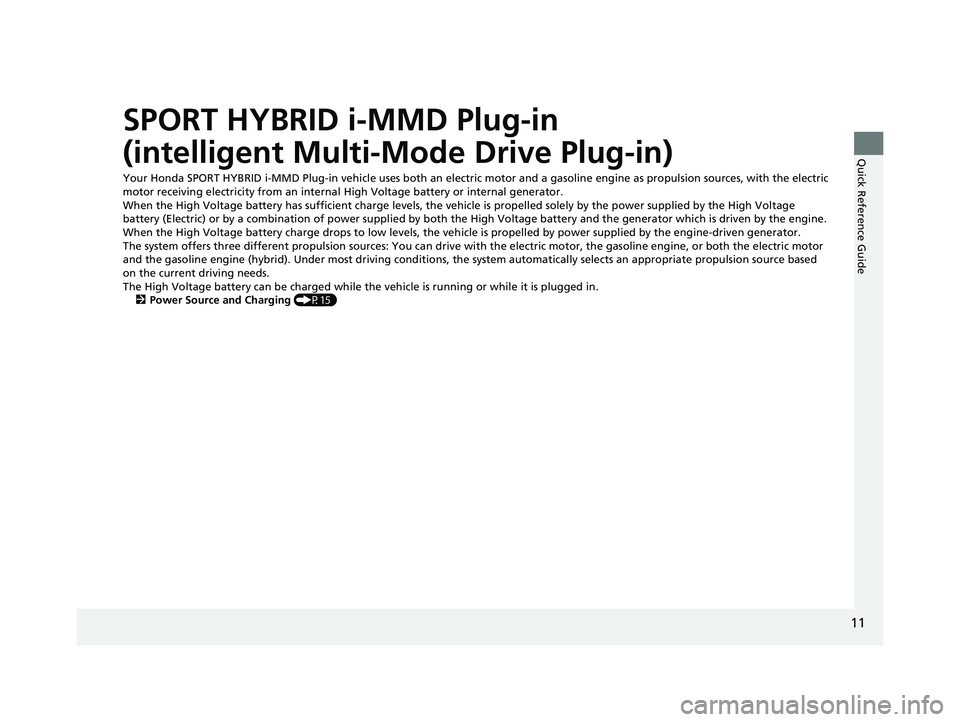
11
Quick Reference Guide
SPORT HYBRID i-MMD Plug-in
(intelligent Multi-Mode Drive Plug-in)
Your Honda SPORT HYBRID i-MMD Plug-in vehicle uses both an electric motor and a gasoline engine as propulsion sources, with the electric
motor receiving electricity from an internal High Voltage battery or internal generator.
When the High Voltage battery has sufficient charge levels, the vehicle is propelled solely by the power supplied by the High V oltage
battery (Electric) or by a combination of power supplied by both the High Voltage battery and the generator which is driven by the engine.
When the High Voltage battery charge drops to low levels, the ve hicle is propelled by power supplied by the engine-driven generator.
The system offers three different propulsion sources: You can dr ive with the electric motor, the gasoline engine, or both the e lectric motor
and the gasoline engine (hybrid). Under most driving conditions , the system automatically selects an appropriate propulsion source based
on the current driving needs.
The High Voltage battery can be charged while the vehicle is running or while it is plugged in. 2 Power Source and Charging (P15)
20 CLARITY PHEV-31TRW6200.book 11 ページ 2019年9月24日 火曜日 午後12時9分
Page 14 of 595
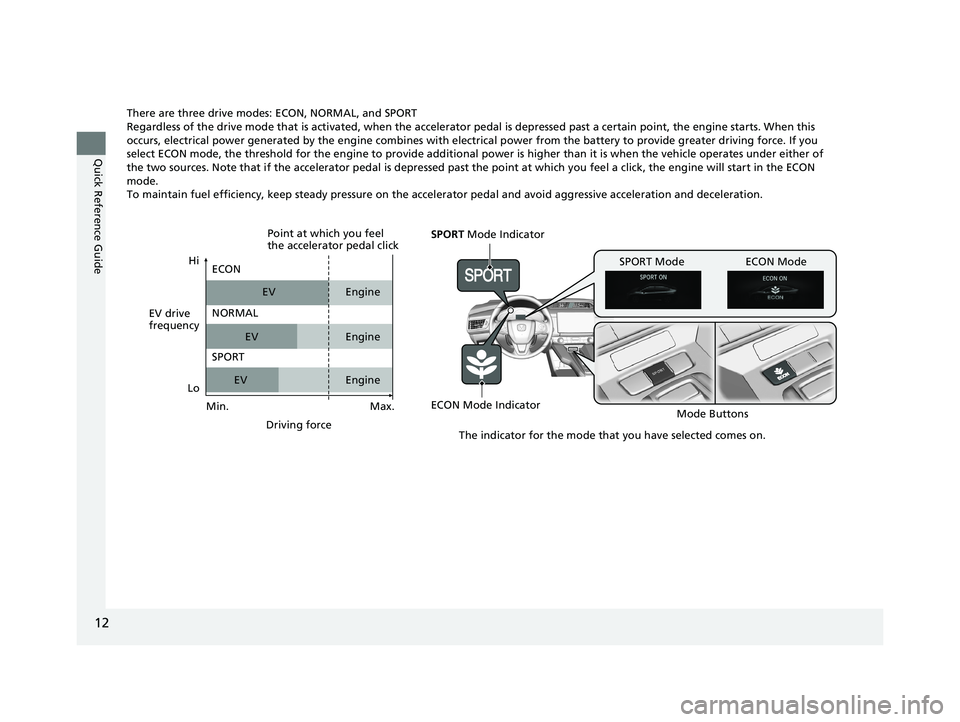
12
Quick Reference Guide
There are three drive modes: ECON, NORMAL, and SPORT
Regardless of the drive mode that is activated, when the accelerator pedal is depr essed past a certain point, the engine starts . When this
occurs, electrical power generated by the en gine combines with electrical power from the battery to provide greater driving force. If you
select ECON mode, the threshold for the engine to provide additional power is higher than it is when the vehicle operates under either of
the two sources. Note that if the accelerator pedal is depressed past the point at which you feel a click, the engine will star t in the ECON
mode.
To maintain fuel efficiency, keep steady pressure on the accelerator pedal and avoid aggressive acceleration and deceleration.
SPORT Mode Indicator
ECON Mode Indicator Mode Buttons
SPORT Mode ECON Mode
The indicator for the mode that you have selected comes on.
EV drive
frequencyHi
Max.
Driving force
ECON
NORMAL
SPORT
EV
EV
EV Engine
Engine
Engine
Point at which you feel
the accelerator pedal click
Min.
Lo
20 CLARITY PHEV-31TRW6200.book 12 ページ 2019年9月24日 火曜日 午後12時9分
Page 15 of 595
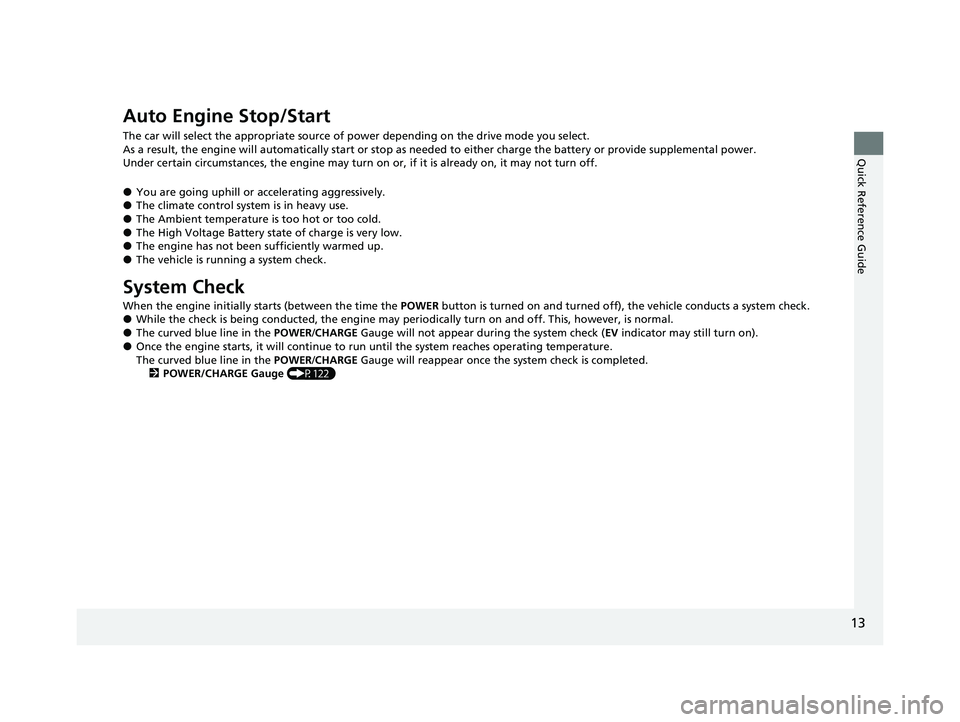
13
Quick Reference Guide
Auto Engine Stop/Start
The car will select the appropriate source of power depending on the drive mode you select.
As a result, the engine will automatically start or stop as needed to either charge the battery or provide supplemental power.
Under certain circumstances, the engine may turn on or, if it is already on, it may not turn off.
●You are going uphill or accelerating aggressively.●The climate control system is in heavy use.●The Ambient temperature is too hot or too cold.●The High Voltage Battery state of charge is very low.●The engine has not been sufficiently warmed up.●The vehicle is running a system check.
System Check
When the engine initially starts (between the time the POWER button is turned on and turned of f), the vehicle conducts a system check.●While the check is being conducted, the engine may periodically turn on and off. This, however, is normal.●The curved blue line in the POWER/CHARGE Gauge will not appear during the system check ( EV indicator may still turn on).●Once the engine starts, it will continue to run until the system reaches operating temperature.
The curved blue line in the POWER/CHARGE Gauge will reappear once the system check is completed.
2 POWER/CHARGE Gauge (P122)
20 CLARITY PHEV-31TRW6200.book 13 ページ 2019年9月24日 火曜日 午後12時9分
Page 16 of 595
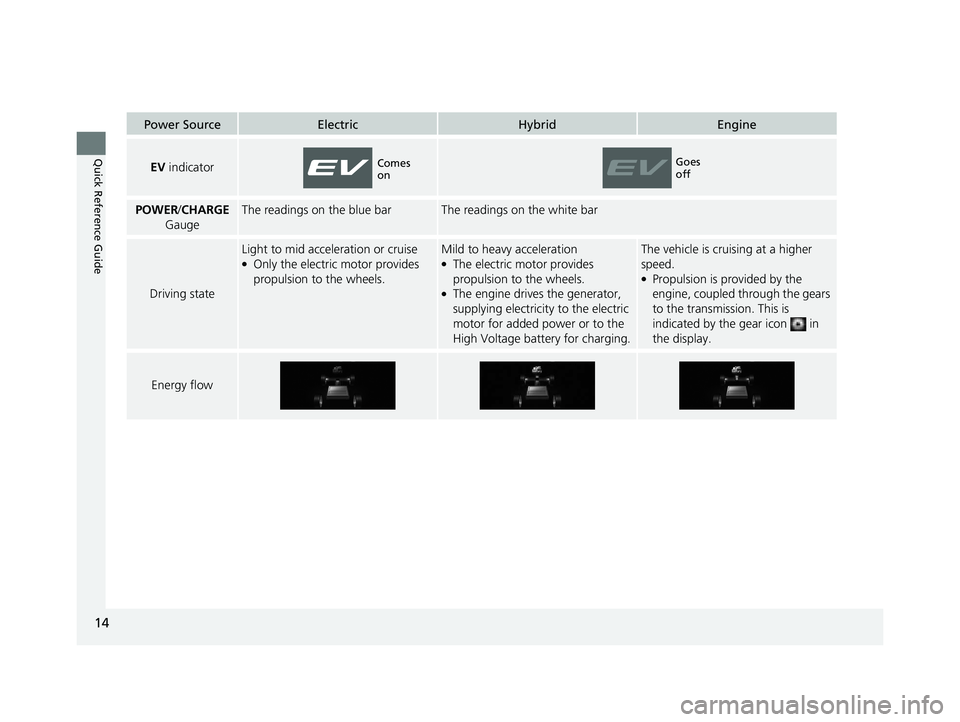
14
Quick Reference Guide
Power SourceElectricHybridEngine
EV indicator
POWER /CHARGE
GaugeThe readings on the blue barThe readings on the white bar
Driving state
Light to mid acceleration or cruise●Only the electric motor provides
propulsion to the wheels.
Mild to heavy acceleration●The electric motor provides
propulsion to the wheels.
●The engine drives the generator,
supplying electricity to the electric
motor for added power or to the
High Voltage battery for charging.
The vehicle is cruising at a higher
speed.
●Propulsion is provided by the
engine, coupled through the gears
to the transmission. This is
indicated by the gear icon in
the display.
Energy flow
Comes
onGoes
off
20 CLARITY PHEV-31TRW6200.book 14 ページ 2019年9月24日 火曜日 午後12時9分
Page 17 of 595
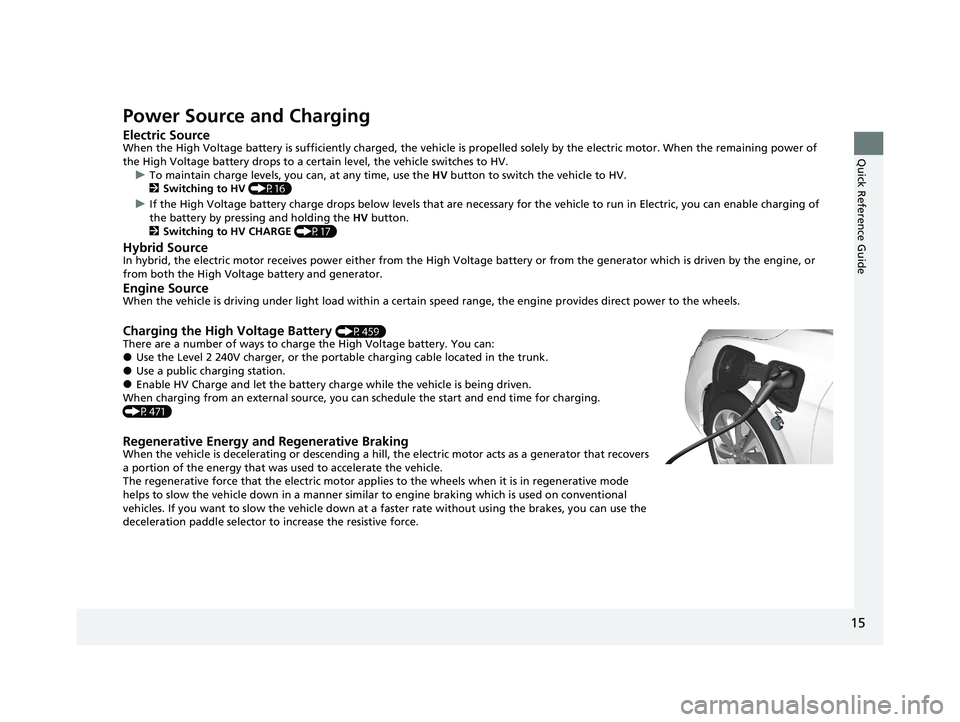
15
Quick Reference Guide
Power Source and Charging
Electric SourceWhen the High Voltage battery is sufficiently charged, the vehicle is propelled solely by the electric motor. When the remaining power of
the High Voltage battery drops to a certain level, the vehicle switches to HV. u To maintain charge levels, you can, at any time, use the HV button to switch the vehicle to HV.
2 Switching to HV (P16)
u If the High Voltage battery charge drops below levels that are necessary for the vehicle to run in Electric, you can enable charging of
the battery by pressing and holding the HV button.
2 Switching to HV CHARGE (P17)
Hybrid SourceIn hybrid, the electric motor receives powe r either from the High Voltage battery or from the generator which is driven by the engine, or
from both the High Volt age battery and generator.
Engine SourceWhen the vehicle is driving under light load within a certain speed range, the engine provides direct power to the wheels.
Charging the High Voltage Battery (P459)
There are a number of ways to charge the High Voltage battery. You can:
●Use the Level 2 240V charger, or the portable charging cable located in the trunk.●Use a public charging station.●Enable HV Charge and let the battery charge while the vehicle is being driven.
When charging from an external source, you ca n schedule the start and end time for charging.
(P471)
Regenerative Energy and Regenerative BrakingWhen the vehicle is decelerating or descending a hill, the electric motor acts as a generator that recovers
a portion of the energy that was used to accelerate the vehicle.
The regenerative force that the electric motor applie s to the wheels when it is in regenerative mode
helps to slow the vehicle down in a manner similar to engine braking which is used on conventional
vehicles. If you want to slow the vehicle down at a faster rate without using the brakes, you can use the
deceleration paddle selector to increase the resistive force.
20 CLARITY PHEV-31TRW6200.book 15 ページ 2019年9月24日 火曜日 午後12時9分
Page 18 of 595
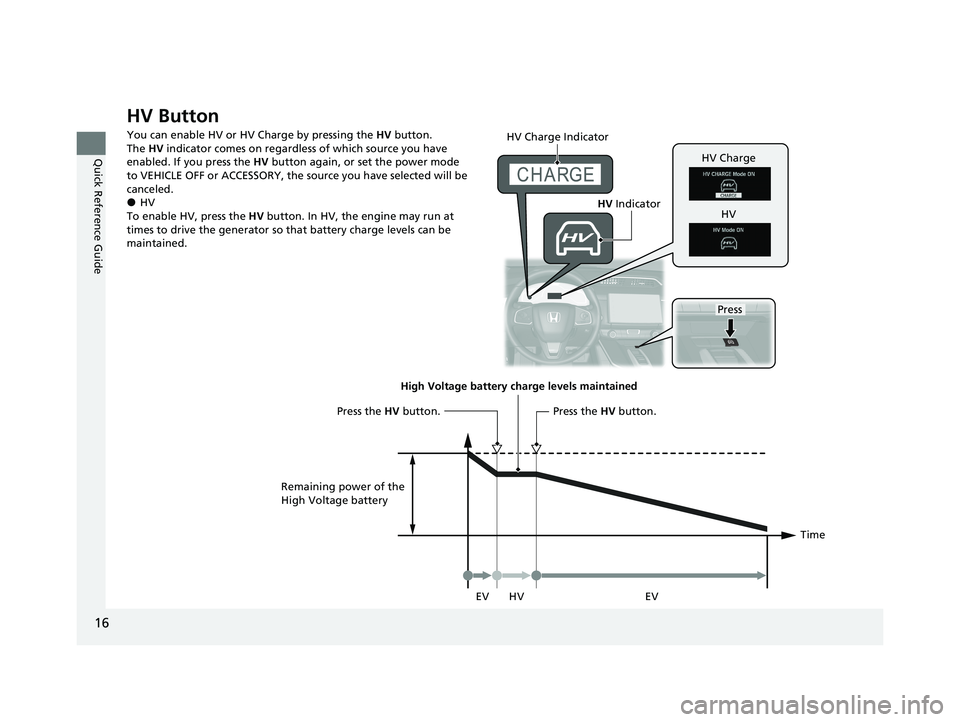
16
Quick Reference Guide
HV Button
You can enable HV or HV Charge by pressing the HV button.
The HV indicator comes on regardless of which source you have
enabled. If you press the HV button again, or set the power mode
to VEHICLE OFF or ACCESSORY, the source you have selected will be
canceled.
●HV
To enable HV, press the HV button. In HV, the engine may run at
times to drive the generator so that battery charge levels can be
maintained.
Press
HV Charge Indicator
HV
Indicator
HV Charge
HV
Time
High Voltage battery charge levels maintained
HV
Remaining power of the
High Voltage battery
Press the
HV button.Press the HV button.
EV EV
20 CLARITY PHEV-31TRW6200.book 16 ページ 2019年9月24日 火曜日 午後12時9分
Page 19 of 595
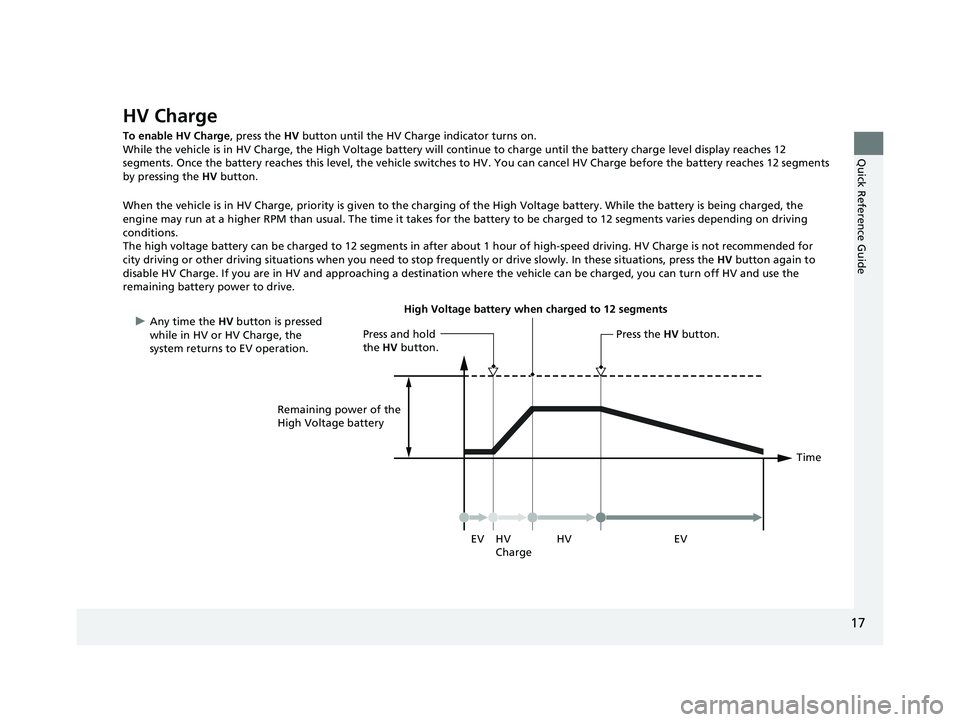
17
Quick Reference Guide
HV Charge
To enable HV Charge, press the HV button until the HV Charge indicator turns on.
While the vehicle is in HV Charge, the High Voltage battery will continue to charge until the battery charge level display reac hes 12
segments. Once the battery reaches this leve l, the vehicle switches to HV. You can cancel HV Charge before the battery reaches 12 segments
by pressing the HV button.
When the vehicle is in HV Charge, priority is given to the charging of the High Voltage battery. While the battery is being charged, the
engine may run at a higher RPM than usual. The time it takes for the battery to be charged to 12 segments varies depending on d riving
conditions.
The high voltage battery can be charged to 12 segments in after about 1 hour of high-speed driving. HV Charge is not recommende d for
city driving or other driving situations when you need to stop frequently or driv e slowly. In these situations, press the HV button again to
disable HV Charge. If you are in HV and approaching a destination where the vehicle can be charged, you can turn off HV and use the
remaining battery power to drive.
Time
High Voltage battery when charged to 12 segments
HV
Charge
Remaining power of the
High Voltage battery
Press and hold
the HV
button.Press the HV button.
EV EV
HV
u
Any time the HV button is pressed
while in HV or HV Charge, the
system returns to EV operation.
20 CLARITY PHEV-31TRW6200.book 17 ページ 2019年9月24日 火曜日 午後12時9分